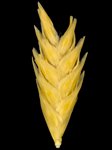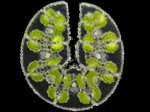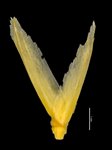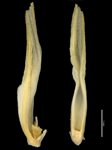
T. spicata spikelet.

T. spicata leaf section.

T. spicata glumes.

T. spicata lemmas.

T. spicata paleas.

T. spicata map.
Name
Triodia spicata N.T. Burb.
Citation
Austral. J. Bot. 1: 182–183 (1953)
Derivation
spicata — from the Latin spicatus, bearing a spike, in reference to the form of the inflorescence (lacking branches and with ±sessile spikelets).Common name
Spike-flowered Spinifex
Synonyms
None
Diagnostic features
Foliage non-resinous; leaf sheath surfaces lacking hairs; leaf blades amphistomatous (hard-type); orifices with woolly hairs; inflorescence unbranched, the spikelets inserted directly on the main axis; pedicels 0.4–1 mm long; lower glume 3.5–6.5 mm long, with 1–3 nerves; lemmas hairy on midline and margin, apex acute and entire, not lobed, not awned, uniformly textured; only on rocky hills in the northern Little Sandy Desert region just east of the Pilbara.
Habitat
Occurs on rocky hills, one of the two known locations recorded on sandstone.
Distribution and frequency
T. spicata occursdisjunctly in the southern NT, the south-eastern Kimberley and just east of the Pilbara bioregion in the Little Sandy Desert (Balfour Downs and Rudall River area). These three disjunct areas are genetically divergent, and more taxonomic investigation is required into their relationships with the Kimberley species T. fissura.
Similar species
Triodia spicata belongs to the Angusta-Wiseana group (as defined here), by virtue of having amphistomatous (hard-type) leaf blades and 1–3-nerved glumes.
It differs from all other members of the Angusta-Wiseana group in having unbranched inflorescences with 3–19 spikelets and pedicels up to 1 mm long (inflorescences branched, and usually with more spikelets and/or longer basal pedicels). Triodia spicata is also nearly unique in Triodia in having entire (not lobed or awned) lemmas.
Three species of the Basedowii group (T. infesta, T. mallota and T. plurinervata) share the unbranched inflorescence form, but all have 6 or more glume nerves (1–3-nerved glumes in T. spicata).Conservation status
Priority Three recommended.
Identification without florets
The features outlined above can be determined in the absence of florets.
Variation
The two known Pilbara collections are quite uniform in features.
Notes
The concept of T. spicata used here is the same as that of Lazarides (1997), Lazarides et al. (2005) and Ausgrass (Sharp & Simon, 2002; Simon & Alonso, 2014), which all include full descriptions, however measurements used in SpiKey are based only on Pilbara specimens.